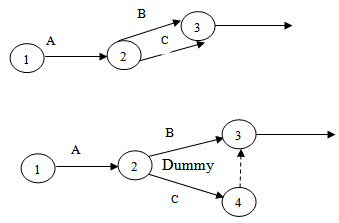Site pages
Current course
Participants
General
MODULE 1. Systems concept
MODULE 2. Requirements for linear programming prob...
MODULE 3. Mathematical formulation of Linear progr...
MODULE 5. Simplex method, degeneracy and duality i...
MODULE 6. Artificial Variable techniques- Big M Me...
MODULE 7.
MODULE 8.
MODULE 9. Cost analysis
MODULE 10. Transporatation problems
MODULE 11. Assignment problems
MODULE 12. waiting line problems
MODULE 13. Network Scheduling by PERT / CPM
MODULE 14. Resource Analysis in Network Scheduling
LESSON 1. NETWORK ANALYSIS
Network analysis is one of the most popular techniques used for planning, scheduling, monitoring and coordinating large and complex projects comprising a number of activities. It involves the development of a network to indicate logical sequence of work content elements of a complex situation. It involves three basic steps:
-
Defining the job to be done
-
Integrating the elements of the job in a logical time sequence
-
Controlling the progress of the project.
Network analysis is concerned with minimizing some measure of performance of the system such as the total completion time for the project, overall cost and so on. By preparing a network of the system, a decision maker can identify,
(i) The physical relationship (properties) of the system
(ii) The inter relationships of the system components
Network analysis is specially suited to project which are not routine or repetitive and which will be conducted only once or a few times.
Objectives:
Network analysis can be used to serve the following objectives:
-
Minimization of total time: Network analysis is useful in completing a project in the minimum possible time. A good example of this objective is the maintenance of production line machinery in a factory. If the cost of down time is very high, it is economically desirable to minimize time despite high resource costs.
-
Minimization of total cost: Where the cost of delay in the completion of the project exceeds cost of extra effort, it is desirable to complete the project in time so as to minimize total cost.
-
Minimization of time for a given cost: When fixed sum is available to cover costs, it may be preferable to arrange the existing resources so as to reduce the total time for the project instead of reducing total cost.
-
Minimization of cost for a given total time: When no particular benefit will be gained from completing the project early, it may be desirable to arrange resources in such a way as to give the minimum cost for the project in the set time.
-
Minimization of idle resources: The schedule should be devised to minimize large fluctuations in the use of limited resources. The cost of having men/machines idle should be compared with the cost of hiring resources on a temporary basis.
-
Network analysis can also be employed to minimize production delays, interruptions and conflicts.
Managerial Applications :
Network analysis can be applied to very wide range of situations involving the use of time, labour and physical resources. Some of the more common applications of network analysis in project scheduling are as follows:
-
Construction of bridge, highway, power plant etc.
-
Assembly line scheduling.
-
Installation of a complex new equipment. Eg., computers, large machinery.
-
Research and Development
-
Maintenance and overhauling complicated equipment in chemical or power plants, steel and petroleum industries, etc.
-
Inventory planning and control.
-
Shifting of manufacturing plant from one site to another.
-
Development and testing of missile system.
-
Development and launching of new products and advertising campaigns.
-
Repair and maintenance of an oil refinery.
-
Construction of residential complex.
-
Control of traffic flow in metropolitan cities.
-
Long range planning and developing staffing plans.
-
Budget and audit procedures.
-
Organization of international conferences.
-
Launching space programmes, etc.
A network is a graphic representation of a project’s operations and is composed of activities and events (or nodes) that must be completed to reach the end objective of a project, showing the planning sequence of their accomplishments, their dependence and inter relationships.
Basic Components
Events (node)
A specific point in time at which an activity begins and ends is called a node. It is recognizable as a particular instant in time and does not consume time or resource. An event is generally represented on the network by a circle, rectangle, hexagon or some other geometric shape.
Activity
An activity is a task, or item of work to be done, that consumes time, effort, money or other resources. It lies between two events, called the ‘Preceding’ and ‘Succeeding’ ones. An activity is represented on the network by an arrow with its head indicating the sequence in which the events are to occur.
Head event Tail event
![]()
Preceding event Succeeding event
Predecessor Activity:
An activity which must be completed before one or more other activities start is known as Predecessor activity.
Successor Activity:
An activity which started immediately after one or more of other activities are completed is known as Successor activity.
Dummy Activity:
Certain activities which neither consume time nor resources but are used simply to represent a connection between events are known as dummies. A dummy activity is depicted by dotted line in the network diagram.
A dummy activity in the network is added only to represent the given precedence relationships among activities of the project and is needed when (a) two or more parallel activities in a project have same head and tail events, or (b) two or more activities have some (but not all) of their immediate predecessor activities in common.
